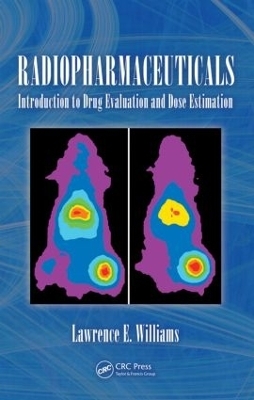
Radiopharmaceuticals
Crc Press Inc (Verlag)
978-1-4398-1067-5 (ISBN)
Offering the unique perspective of a medical physicist who has worked directly with cancer patients for over three decades, Radiopharmaceuticals: Introduction to Drug Evaluation and Dose Estimation starts by exploring the recent history and current state of the field. Then, citing key research and practical examples, the author looks at how to run studies and employ estimation and evaluation methods that lead to the best multiple agents with the least amount of trial and error. He discusses methods that will allow researchers to more rigorously:
Differentiate one radiopharmaceutical (RP) from another
Estimate radiation doses
Correlate results across various species to realize more informed data from clinical trials
Incorporating developments in nanotechnology and radiology, with the ultimate goal of achieving personalized patient-specific treatment, this book crosses disciplines to addresses a range of topics including:
Preclinical RP development
Organization of clinical trials
Determination of activity in vivo
Modeling and temporal integration with a look at the mass law for tumor uptake as a function of tumor size (discovered by the author)
Absorbed dose estimates with and without clinical correlations
Multiple-modality therapy
Dr. Lawrence Williams has devoted most of his life’s research to tumor detection and treatment, and his discoveries continue to influence evolving therapies. As s a medical physicist, he is eminently qualified to bring unique insight into the discussion of radiopharmaceutical dosage rates and efficacy.
Lawrence E. Williams, Ph.D., is a professor of radiology and an imaging physicist at City of Hope National Medical Center in Duarte, California. In addition, he is an adjunct professor of radiology at University of California–Los Angeles (UCLA). While in high school, he was one of 40 national winners of the Westinghouse (now Intel) Science Talent Search. Dr. Williams obtained his B.S. from Carnegie Mellon University and his M.S. and Ph.D. degrees (both in physics) from the University of Minnesota, where he was a National Science Foundation (NSF) fellow. His initial graduate training was in nuclear reactions at Minnesota, where he demonstrated excited states of the mass-4 system (4He*). He later extended this work by finding excited levels of mass-3 nuclides while working at the Rutherford High Energy Laboratory in England. Since obtaining the National Institutes of Health (NIH) support to become a medical physicist, Dr. Williams has devoted most of his research to tumor detection and treatment and has written approximately 250 total publications as well as a number of patents in nuclear imaging and radionuclide therapy. He is a coauthor of Biophysical Science (Prentice Hall, 1979) and editor of Nuclear Medicine Physics (CRC Press, 1987). He has been a grant and site reviewer for NIH since the mid-1990s. Dr. Williams is associate editor of Medical Physics and a reviewer for several other journals. He is a member of the American Association of Physicists in Medicine (AAPM), the Society of Nuclear Medicine, the New York Academy of Sciences, Sigma Xi, Society of Imaging Informatics in Medicine (SIIM), and the Society of Breast Imaging. Dr. Williams has received a lifetime service award from the American Board of Radiology. Among Dr. Williams’ most significant biophysical discoveries is the mass-law for tumor uptake as a function of tumor size. He was also codiscoverer (with Richard Proffitt) of tumor targeting with liposomes. This work involved one of the first applications of normal organ blockage by use of an unlabeled agent—that is, a two-step process. Dr. Williams has developed a pair of indices for quantifying the ability of a radiopharmaceutical to permit imaging or therapy of lesions in animals or patients. He has also demonstrated that radioactive decay must be considered inherently as one possible exit route in modeling analysis of radioactive drugs. With his colleagues at City of Hope, Dr. Williams measured and calculated the brake radiation dose result for a source of 90Y in a humanoid phantom. This study remains as one of the few examples of a comparison of dose estimates and measurement in the nuclear medicine literature.
Tumor Targeting and a Problem of Plenty. Preclinical Development of Radiopharmaceuticals and Planning of Clinical Trials. Selection of Radiopharmaceuticals for Clinical Trials. Absorbed Dose Estimation and Measurement. Determination of Activity In Vivo. Modeling and Temporal Integration. Functions Used to Determine Absorbed Dose Given Activity Integrals. Absorbed Dose Estimates without Clinical Correlations. Dose Estimates and Correlations with Laboratory and Clinical Results. Multiple-Modality Therapy of Tumors. Allometry (Of Mice and Men). Summary of Radiopharm-aceuticals and Dose Estimation. Index.
| Erscheint lt. Verlag | 14.2.2011 |
|---|---|
| Zusatzinfo | 67 Tables, black and white; 48 Illustrations, black and white |
| Verlagsort | Bosa Roca |
| Sprache | englisch |
| Maße | 156 x 234 mm |
| Gewicht | 770 g |
| Themenwelt | Medizin / Pharmazie ► Allgemeines / Lexika |
| Medizin / Pharmazie ► Medizinische Fachgebiete ► Pharmakologie / Pharmakotherapie | |
| Naturwissenschaften ► Biologie | |
| Naturwissenschaften ► Chemie | |
| Naturwissenschaften ► Physik / Astronomie | |
| ISBN-10 | 1-4398-1067-2 / 1439810672 |
| ISBN-13 | 978-1-4398-1067-5 / 9781439810675 |
| Zustand | Neuware |
| Haben Sie eine Frage zum Produkt? |
aus dem Bereich


